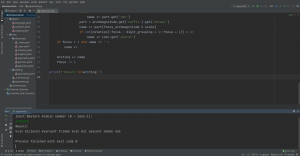Difference between revisions of "Language/Multiple-languages/Culture/Numeration-Tutorial"
| Line 1: | Line 1: | ||
Finally, the first version of the Numeration tool is released! This version will allow you to practise Esperanto numerals | Finally, the first version of the Numeration tool is released! This version will allow you to practise English and Esperanto numerals! More languages to come... | ||
[[File:Numeration 20201008.png|thumb|none]] | [[File:Numeration 20201008.png|thumb|none]] | ||
Revision as of 20:30, 25 October 2020
Finally, the first version of the Numeration tool is released! This version will allow you to practise English and Esperanto numerals! More languages to come...
What is the Numeration tool?
This tool will help you practise reading, writing (hopefully also listening and speaking) numbers, written in Python and YAML.
The Numeration project is for practising conversion of numbers between symbols and writing systems.
Address: https://gitlab.com/GrimPixel/Numeration
NB: It would be ridiculous to post this tutorial on GitLab, because this tutorial's target readers are non-programmers, so it is too detailed for programmers.
What are Python and YAML and why choose them?
Python
Python is one of the most favoured languages.
Why not Rust or TypeScript, but Python? Well, because Python codes are very easy to maintain, Python also has some unique useful features including f-string and negative indexing. In addition, Python has a lot of scientific libraries, so it is more relevant to my main area of study.
YAML
YAML is one of the most useful data serialization formats.
And why not JSON or TOML, but YAML? Because YAML has high readability and is very easy to maintain, at least no need to type soo many quotation marks.
By the way, XML is not that horrible as described in that linked page. That is a joke with escape characters.
How to get started with Numeration?
1. Download the latest Python and install it, so you can run Python programs
2. Download PyCharm, an integrated development environment (IDE), and install it, so you have a graphical user interface (GUI) to edit the code or run it. Alternative: Pyzo.
3. Download Python's YAML parser, so that Python interpreter can understand YAML. If you are using Windows, tap WinKey, input "cmd", tap Enter, so the command line is opened. Copy the line starting with "pip" in that webpage, paste into the command line window, tap Enter. For users of other operating systems, you should already have known how to open the command line of your system, I suppose.
They are all open-source.
After doing this, go to that Address above. Download the source code and extract the compressed file. Keep the directory structure unchanged, otherwise you need to change the code to run the program.
Open PyCharm, open the project directory, open 'numerate.py'.
Tap "Ctrl + Shift + F10" to run the code in current tab. Tap "Shift + F10" to run the code in the file specified on the upper-right corner.
You can go to “File -> Settings -> Appearances & Behavior -> Appearance” to change the font and its size.
If you are still confused about PyCharm, please watch the first sections of that Mosh's tutorial above.
Why choose Apache 2.0?
I want to let people use this even commercially, e.g. in language-learning games like Influent. Thus I need a permissive license. You may ask why not public domain. It's disputable whether people can truly release software in public domain when they are alive.
MIT is good, but there is a problem: it doesn't explain how to deal with patents and trade marks. This allows patent trolls to sue those who use the code commercially without knowing that it contains patent. When the MIT license came into being, there was no software patent, so the license can be called outdated.
A guy named Lawrence E. Rosen created the Academic Free License to deal with this issue and this idea was incorporated into Apache 2.0, a better alternative.
What's the future plan?
I need to add support to other 4 languages mentioned in 'about/language.yaml' and notations mentioned in 'about/notation.yaml', then I will start supporting other languages covering as many language families as possible, so that people can copy the code of the language in the same family, modify it to support a new language. I will add a guidance on adding a new language, add the TTS support and maybe the SR support, create a GUI with BeeWare. I need to accumulate experience through this project, then I can create other ones.
